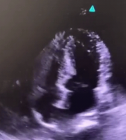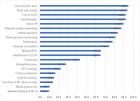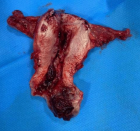Abstract
Case Report
Cardiac Tamponade as the Cause of Pulmonary Edema: Case Report
Emídio Lima*
Published: 17 August, 2023 | Volume 7 - Issue 2 | Pages: 021-023
Introduction: Cardiac tamponade is an emergency syndrome that requires fast diagnosis and treatment; otherwise patient follows obstructive shock and cardiac arrest.
Case report: A 70-year-old female was brought to the emergency department with hypoxemia. She had a history of progressive dyspnea over the past three weeks. Past medical history includes smoking. On physical examination: tachypnea, hypoxemia (SaO2 89%), jugular venous distention, arterial pressure 220/100 mmHg, heart rate rhythmic of 82 bpm. On pulmonary auscultation: diffuse and bilateral crackles. Lung ultrasound showed a bilateral B line and the echocardiogram demonstrated a pericardial effusion with signs of tamponade. A pericardiocentesis evacuated 620 ml of hemorrhagic fluid and the patient was transferred to the intensive care unit, hemodynamically stable, with SaO2 95%. At the ICU the echocardiogram, showed resolution of the cardiac tamponade and a tumor adhered to the lateral wall of the left ventricle. Chest CT demonstrated: a left lung tumor, infiltrating the pericardial sac. A pericardium biopsy demonstrated undifferentiated carcinoma.
Discussion: Cardiac tamponade diagnosis requires a high level of suspicion. Respiratory failure, chest pain, and shock, observed in cardiac tamponade, are also present in different diseases. The most common finding of cardiac tamponade is dyspnea (78% of cases). Our patient had dyspnea due to pulmonary edema, secondary to left ventricle diastolic dysfunction caused by the tamponade. A bedside echocardiogram made the diagnosis of cardiac tamponade and guided the effective pericardiocentesis.
Conclusion: Cardiac tamponade must be suspected in all cases of acute dyspnea. Echocardiogram is the method of choice for the diagnosis and for guiding the pericardiocentesis.
Read Full Article HTML DOI: 10.29328/journal.jprr.1001046 Cite this Article Read Full Article PDF
Keywords:
Cardiac tamponade; Bedside echocardiogram; Point of care ultrasound; Pericardiocentesis; Lung ultrasound
References
- Demetriades D. Cardiac wounds. Experience with 70 patients. Ann Surg. 1986 Mar;203(3):315-7. doi: 10.1097/00000658-198603000-00018. PMID: 3954485; PMCID: PMC1251098.
- Scheinin SA, Sosa-Herrera J. Case report: cardiac tamponade resembling an acute myocardial infarction as the initial manifestation of metastatic pericardial adenocarcinoma. Methodist Debakey Cardiovasc J. 2014 Apr-Jun;10(2):124-8. doi: 10.14797/mdcj-10-2-124. PMID: 25114766; PMCID: PMC4117332.
- Yarlagadda C. Cardiac tamponade: practice, essentials, background and pathophysiology. http://emedicine.medscape.com/article/152083- overview#showall
- Stashko E, Meer JM. Cardiac Tamponade. National Library of Medicine. https://www.ncbi.nlm.nih.gov/books/NBK431090/.
- Martins QC, Juliano C. Pericardial Effusion and Cardiac Tamponade: Etiology and Evolution in the Contemporary Era. Int J Cardiovasc Sci. 25/out/2021. 34(5 supl 1) 24-31.
- Bottinor W, Fronk D, Sadruddin S, Foster H, Patel N, Prinz A, Jovin IS. Acute Cardiac Tamponade in a 58-Year-Old Male with Poststreptococcal Glomerulonephritis. Methodist Debakey Cardiovasc J. 2016 Sep;12(3):175-176. doi: 10.14797/mdcj-12-3-175. PMID: 27826373; PMCID: PMC5098576.
- Chong HH, Plotnick GD. Pericardial effusion and tamponade: evaluation, imaging modalities, and management. Compr Ther. 1995 Jul;21(7):378-85. PMID: 7554815.
- Lima E. Cardiac Tamponade as Cause of Respiratory Distress and Cardiac Arrest. J.Clin Case Stu. 2018; 3(3): dx.doi.org/10.16966/24714925.174
- Petcu DP, Petcu C, Popescu CF, Bătăiosu C, Alexandru D. Clinical and cytological correlations in pericardial effusions with cardiac tamponade. Rom J Morphol Embryol. 2009;50(2):251-6. PMID: 19434319.
- Cornily JC, Pennec PY, Castellant P, Bezon E, Le Gal G, Gilard M, Jobic Y, Boschat J, Blanc JJ. Cardiac tamponade in medical patients: a 10-year follow-up survey. Cardiology. 2008;111(3):197-201. doi: 10.1159/000121604. Epub 2008 Apr 25. PMID: 18434725.
- Barra LD. Acute cardiac tamponade: a brief review. Medical Journal of Minas Gerais. 2008; 18(3 supl 4): S37-S40.
Figures:

Figure 1

Figure 2
Similar Articles
-
Cardiac Tamponade as the Cause of Pulmonary Edema: Case ReportEmídio Lima*. Cardiac Tamponade as the Cause of Pulmonary Edema: Case Report. . 2023 doi: 10.29328/journal.jprr.1001046; 7: 021-023
Recently Viewed
-
A Low-cost High-throughput Targeted Sequencing for the Accurate Detection of Respiratory Tract PathogenChangyan Ju, Chengbosen Zhou, Zhezhi Deng, Jingwei Gao, Weizhao Jiang, Hanbing Zeng, Haiwei Huang, Yongxiang Duan, David X Deng*. A Low-cost High-throughput Targeted Sequencing for the Accurate Detection of Respiratory Tract Pathogen. Int J Clin Virol. 2024: doi: 10.29328/journal.ijcv.1001056; 8: 001-007
-
A Comparative Study of Metoprolol and Amlodipine on Mortality, Disability and Complication in Acute StrokeJayantee Kalita*,Dhiraj Kumar,Nagendra B Gutti,Sandeep K Gupta,Anadi Mishra,Vivek Singh. A Comparative Study of Metoprolol and Amlodipine on Mortality, Disability and Complication in Acute Stroke. J Neurosci Neurol Disord. 2025: doi: 10.29328/journal.jnnd.1001108; 9: 039-045
-
Development of qualitative GC MS method for simultaneous identification of PM-CCM a modified illicit drugs preparation and its modern-day application in drug-facilitated crimesBhagat Singh*,Satish R Nailkar,Chetansen A Bhadkambekar,Suneel Prajapati,Sukhminder Kaur. Development of qualitative GC MS method for simultaneous identification of PM-CCM a modified illicit drugs preparation and its modern-day application in drug-facilitated crimes. J Forensic Sci Res. 2023: doi: 10.29328/journal.jfsr.1001043; 7: 004-010
-
A Gateway to Metal Resistance: Bacterial Response to Heavy Metal Toxicity in the Biological EnvironmentLoai Aljerf*,Nuha AlMasri. A Gateway to Metal Resistance: Bacterial Response to Heavy Metal Toxicity in the Biological Environment. Ann Adv Chem. 2018: doi: 10.29328/journal.aac.1001012; 2: 032-044
-
Obesity in Patients with Chronic Obstructive Pulmonary Disease as a Separate Clinical PhenotypeDaria A Prokonich*, Tatiana V Saprina, Ekaterina B Bukreeva. Obesity in Patients with Chronic Obstructive Pulmonary Disease as a Separate Clinical Phenotype. J Pulmonol Respir Res. 2024: doi: 10.29328/journal.jprr.1001060; 8: 053-055
Most Viewed
-
Evaluation of Biostimulants Based on Recovered Protein Hydrolysates from Animal By-products as Plant Growth EnhancersH Pérez-Aguilar*, M Lacruz-Asaro, F Arán-Ais. Evaluation of Biostimulants Based on Recovered Protein Hydrolysates from Animal By-products as Plant Growth Enhancers. J Plant Sci Phytopathol. 2023 doi: 10.29328/journal.jpsp.1001104; 7: 042-047
-
Sinonasal Myxoma Extending into the Orbit in a 4-Year Old: A Case PresentationJulian A Purrinos*, Ramzi Younis. Sinonasal Myxoma Extending into the Orbit in a 4-Year Old: A Case Presentation. Arch Case Rep. 2024 doi: 10.29328/journal.acr.1001099; 8: 075-077
-
Feasibility study of magnetic sensing for detecting single-neuron action potentialsDenis Tonini,Kai Wu,Renata Saha,Jian-Ping Wang*. Feasibility study of magnetic sensing for detecting single-neuron action potentials. Ann Biomed Sci Eng. 2022 doi: 10.29328/journal.abse.1001018; 6: 019-029
-
Pediatric Dysgerminoma: Unveiling a Rare Ovarian TumorFaten Limaiem*, Khalil Saffar, Ahmed Halouani. Pediatric Dysgerminoma: Unveiling a Rare Ovarian Tumor. Arch Case Rep. 2024 doi: 10.29328/journal.acr.1001087; 8: 010-013
-
Physical activity can change the physiological and psychological circumstances during COVID-19 pandemic: A narrative reviewKhashayar Maroufi*. Physical activity can change the physiological and psychological circumstances during COVID-19 pandemic: A narrative review. J Sports Med Ther. 2021 doi: 10.29328/journal.jsmt.1001051; 6: 001-007

HSPI: We're glad you're here. Please click "create a new Query" if you are a new visitor to our website and need further information from us.
If you are already a member of our network and need to keep track of any developments regarding a question you have already submitted, click "take me to my Query."

















































































































































